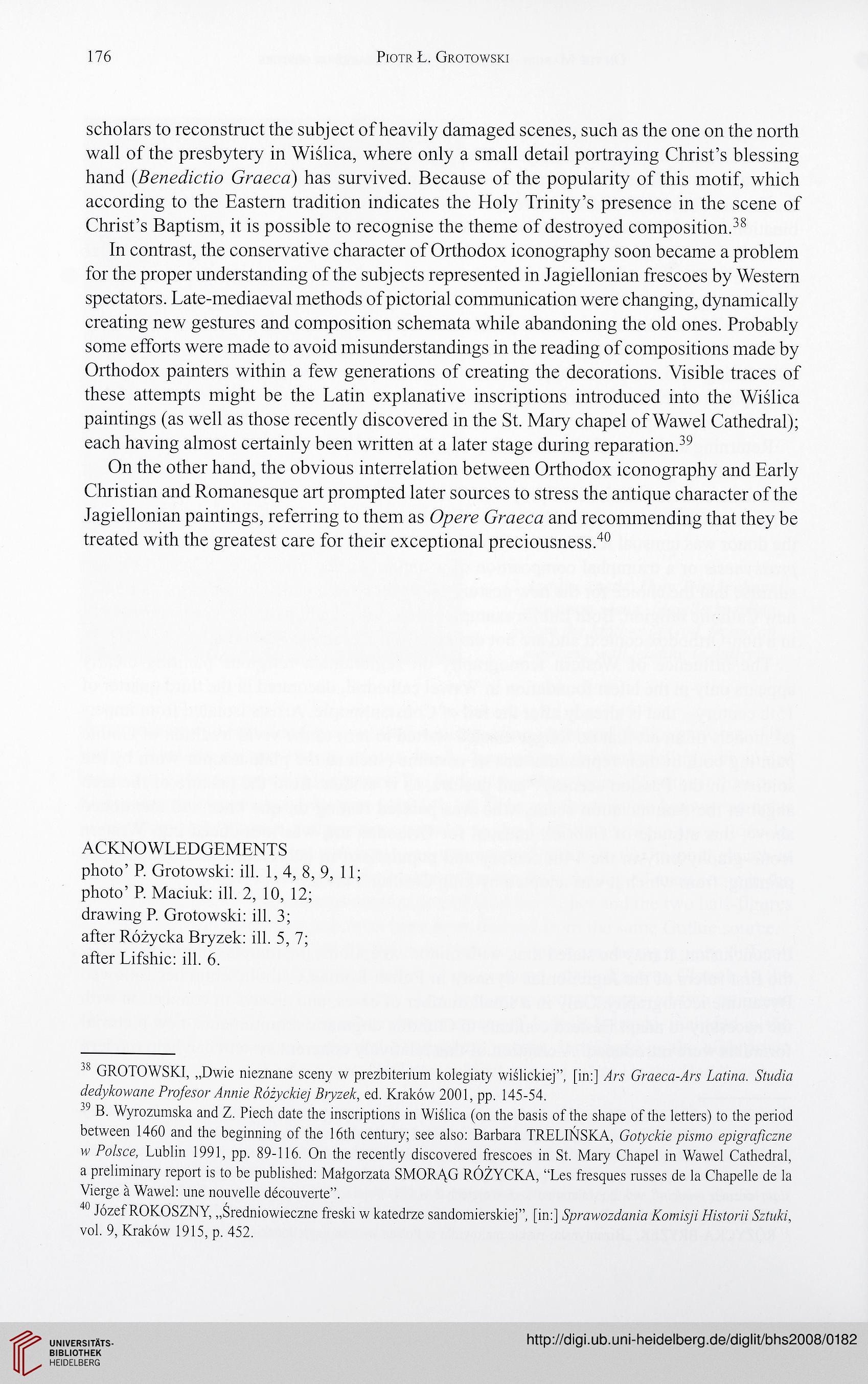176
PlOTR Ł. GROTOWSKI
scholars to reconstruct the subject of heavily damaged scenes, such as the one on the north
wall of the presbytery in Wiślica, where only a small detail portraying Christ's blessing
hand (Æu/iuJûrA'o Grugea) has survived. Because of the popularity of this motif, which
according to the Eastern tradition indicates the Holy Trinity's presence in the scene of
Christ's Baptism, it is possible to recognise the theme of destroyed composition.^
In contrast, the conservative character of Orthodox iconography soon became a problem
for the proper understanding of the subjects represented in Jagiellonian frescoes by Western
spectators. Late-mediaeval methods of pictorial communication were changing, dynamically
creating new gestures and composition schemata while abandoning the old ones. Probably
some efforts were made to avoid misunderstandings in the reading of compositions made by
Orthodox painters within a few generations of creating the decorations. Visible traces of
these attempts might be the Latin explanative inscriptions introduced into the Wiślica
paintings (as well as those recently discovered in the St. Mary chapel of Wawel Cathedral);
each having almost certainly been written at a later stage during reparation.^
On the other hand, the obvious interrelation between Orthodox iconography and Early
Christian and Romanesque art prompted later sources to stress the antique character of the
Jagiellonian paintings, referring to them as Opgrg G/uucu and recommending that they be
treated with the greatest care for their exceptional preciousness.^
ACKNOWLEDGEMENTS
photo' P. Grotowski: ill. 1, 4, 8, 9, 11;
photo' P. Maciuk: ill. 2, 10, 12;
drawing P. Grotowski: ill. 3;
after Różycka Bryzek: ill. 5, 7;
after Lifshic: ill. 6.
^ GROTOWSKI, „Dwie nieznane sceny w prezbiterium kolegiaty wiślickiej", [in:] 4/*^ GraeccHny AaAna.
A/yzgł, ed. Kraków 2001, pp. 145-54.
B. Wyrozumska and Z. Piech date the inscriptions in Wiślica (on the basis of the shape of the letters) to the period
between 1460 and the beginning of the 16th century; see also: Barbara TRELIŃSKA, GotycÆA /?A/no Qw'grq/AzMf
w PoAce, Lublin 1991, pp. 89-116. On the recently discovered frescoes in St. Mary Chapel in Wawel Cathedral,
a preliminary report is to be published: Małgorzata SMORĄG RÓŻYCKA, "Les fresques russes de la Chapelle de la
Vierge à Wawel: une nouvelle découverte".
Józef ROKOSZNY, „Średniowieczne freski w katedrze sandomierskiej", [in:] 6/vv;n'ozA;/!/<r/ Ko/nA/'/ GA/orA .SztiAń
vol. 9, Kraków 1915, p. 452.
PlOTR Ł. GROTOWSKI
scholars to reconstruct the subject of heavily damaged scenes, such as the one on the north
wall of the presbytery in Wiślica, where only a small detail portraying Christ's blessing
hand (Æu/iuJûrA'o Grugea) has survived. Because of the popularity of this motif, which
according to the Eastern tradition indicates the Holy Trinity's presence in the scene of
Christ's Baptism, it is possible to recognise the theme of destroyed composition.^
In contrast, the conservative character of Orthodox iconography soon became a problem
for the proper understanding of the subjects represented in Jagiellonian frescoes by Western
spectators. Late-mediaeval methods of pictorial communication were changing, dynamically
creating new gestures and composition schemata while abandoning the old ones. Probably
some efforts were made to avoid misunderstandings in the reading of compositions made by
Orthodox painters within a few generations of creating the decorations. Visible traces of
these attempts might be the Latin explanative inscriptions introduced into the Wiślica
paintings (as well as those recently discovered in the St. Mary chapel of Wawel Cathedral);
each having almost certainly been written at a later stage during reparation.^
On the other hand, the obvious interrelation between Orthodox iconography and Early
Christian and Romanesque art prompted later sources to stress the antique character of the
Jagiellonian paintings, referring to them as Opgrg G/uucu and recommending that they be
treated with the greatest care for their exceptional preciousness.^
ACKNOWLEDGEMENTS
photo' P. Grotowski: ill. 1, 4, 8, 9, 11;
photo' P. Maciuk: ill. 2, 10, 12;
drawing P. Grotowski: ill. 3;
after Różycka Bryzek: ill. 5, 7;
after Lifshic: ill. 6.
^ GROTOWSKI, „Dwie nieznane sceny w prezbiterium kolegiaty wiślickiej", [in:] 4/*^ GraeccHny AaAna.
A/yzgł, ed. Kraków 2001, pp. 145-54.
B. Wyrozumska and Z. Piech date the inscriptions in Wiślica (on the basis of the shape of the letters) to the period
between 1460 and the beginning of the 16th century; see also: Barbara TRELIŃSKA, GotycÆA /?A/no Qw'grq/AzMf
w PoAce, Lublin 1991, pp. 89-116. On the recently discovered frescoes in St. Mary Chapel in Wawel Cathedral,
a preliminary report is to be published: Małgorzata SMORĄG RÓŻYCKA, "Les fresques russes de la Chapelle de la
Vierge à Wawel: une nouvelle découverte".
Józef ROKOSZNY, „Średniowieczne freski w katedrze sandomierskiej", [in:] 6/vv;n'ozA;/!/<r/ Ko/nA/'/ GA/orA .SztiAń
vol. 9, Kraków 1915, p. 452.




